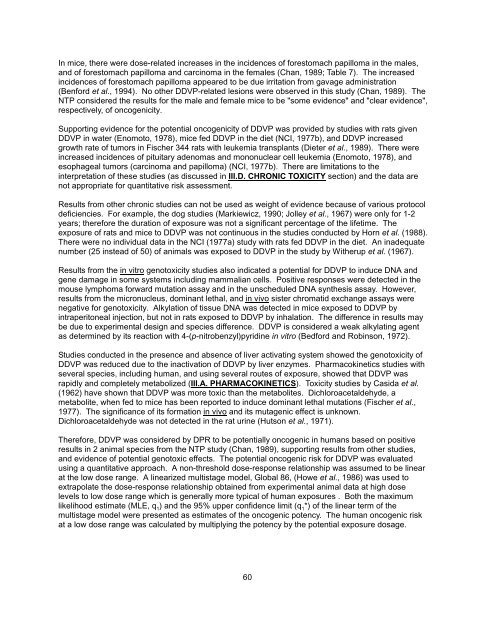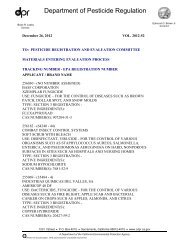Dichlorvos (DDVP) Risk Characterization Document - California ...
Dichlorvos (DDVP) Risk Characterization Document - California ...
Dichlorvos (DDVP) Risk Characterization Document - California ...
Create successful ePaper yourself
Turn your PDF publications into a flip-book with our unique Google optimized e-Paper software.
In mice, there were dose-related increases in the incidences of forestomach papilloma in the males,<br />
and of forestomach papilloma and carcinoma in the females (Chan, 1989; Table 7). The increased<br />
incidences of forestomach papilloma appeared to be due irritation from gavage administration<br />
(Benford et al., 1994). No other <strong>DDVP</strong>-related lesions were observed in this study (Chan, 1989). The<br />
NTP considered the results for the male and female mice to be "some evidence" and "clear evidence",<br />
respectively, of oncogenicity.<br />
Supporting evidence for the potential oncogenicity of <strong>DDVP</strong> was provided by studies with rats given<br />
<strong>DDVP</strong> in water (Enomoto, 1978), mice fed <strong>DDVP</strong> in the diet (NCI, 1977b), and <strong>DDVP</strong> increased<br />
growth rate of tumors in Fischer 344 rats with leukemia transplants (Dieter et al., 1989). There were<br />
increased incidences of pituitary adenomas and mononuclear cell leukemia (Enomoto, 1978), and<br />
esophageal tumors (carcinoma and papilloma) (NCI, 1977b). There are limitations to the<br />
interpretation of these studies (as discussed in III.D. CHRONIC TOXICITY section) and the data are<br />
not appropriate for quantitative risk assessment.<br />
Results from other chronic studies can not be used as weight of evidence because of various protocol<br />
deficiencies. For example, the dog studies (Markiewicz, 1990; Jolley et al., 1967) were only for 1-2<br />
years; therefore the duration of exposure was not a significant percentage of the lifetime. The<br />
exposure of rats and mice to <strong>DDVP</strong> was not continuous in the studies conducted by Horn et al. (1988).<br />
There were no individual data in the NCI (1977a) study with rats fed <strong>DDVP</strong> in the diet. An inadequate<br />
number (25 instead of 50) of animals was exposed to <strong>DDVP</strong> in the study by Witherup et al. (1967).<br />
Results from the in vitro genotoxicity studies also indicated a potential for <strong>DDVP</strong> to induce DNA and<br />
gene damage in some systems including mammalian cells. Positive responses were detected in the<br />
mouse lymphoma forward mutation assay and in the unscheduled DNA synthesis assay. However,<br />
results from the micronucleus, dominant lethal, and in vivo sister chromatid exchange assays were<br />
negative for genotoxicity. Alkylation of tissue DNA was detected in mice exposed to <strong>DDVP</strong> by<br />
intraperitoneal injection, but not in rats exposed to <strong>DDVP</strong> by inhalation. The difference in results may<br />
be due to experimental design and species difference. <strong>DDVP</strong> is considered a weak alkylating agent<br />
as determined by its reaction with 4-(p-nitrobenzyl)pyridine in vitro (Bedford and Robinson, 1972).<br />
Studies conducted in the presence and absence of liver activating system showed the genotoxicity of<br />
<strong>DDVP</strong> was reduced due to the inactivation of <strong>DDVP</strong> by liver enzymes. Pharmacokinetics studies with<br />
several species, including human, and using several routes of exposure, showed that <strong>DDVP</strong> was<br />
rapidly and completely metabolized (III.A. PHARMACOKINETICS). Toxicity studies by Casida et al.<br />
(1962) have shown that <strong>DDVP</strong> was more toxic than the metabolites. Dichloroacetaldehyde, a<br />
metabolite, when fed to mice has been reported to induce dominant lethal mutations (Fischer et al.,<br />
1977). The significance of its formation in vivo and its mutagenic effect is unknown.<br />
Dichloroacetaldehyde was not detected in the rat urine (Hutson et al., 1971).<br />
Therefore, <strong>DDVP</strong> was considered by DPR to be potentially oncogenic in humans based on positive<br />
results in 2 animal species from the NTP study (Chan, 1989), supporting results from other studies,<br />
and evidence of potential genotoxic effects. The potential oncogenic risk for <strong>DDVP</strong> was evaluated<br />
using a quantitative approach. A non-threshold dose-response relationship was assumed to be linear<br />
at the low dose range. A linearized multistage model, Global 86, (Howe et al., 1986) was used to<br />
extrapolate the dose-response relationship obtained from experimental animal data at high dose<br />
levels to low dose range which is generally more typical of human exposures . Both the maximum<br />
likelihood estimate (MLE, q 1 ) and the 95% upper confidence limit (q 1 *) of the linear term of the<br />
multistage model were presented as estimates of the oncogenic potency. The human oncogenic risk<br />
at a low dose range was calculated by multiplying the potency by the potential exposure dosage.<br />
60
















